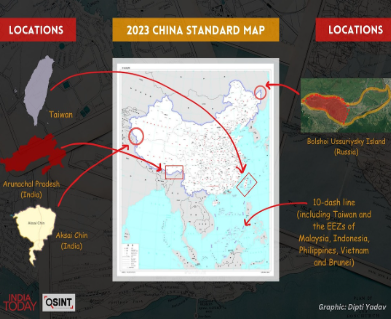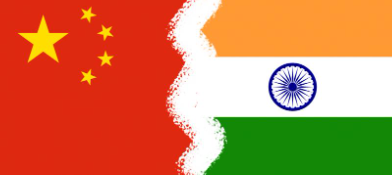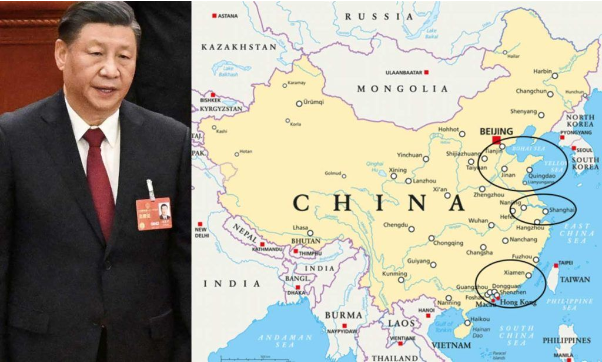Introduction
In recent years, China’s territorial claims and border disputes have caused quite a stir on the international stage and the release of this controversial map by the Chinese government has only added fuel to the fire. This map, which presents China’s extended claims in the South China Sea and its disputed territories with neighboring countries, has been met with strong opposition and rejection from various nations and international bodies. The significance of these maps extends beyond the territorial disputes themselves.
The controversial new map: What does it show?

The release of a controversial new map by China has caused a stir in the international community. This map claims certain territories and maritime regions that are disputed by neighbouring countries and have been the subject of ongoing tensions. But what exactly does this map show?
The new map, officially known as the “Four Sha” map, asserts China’s claims over the South China Sea, including the disputed Spratly Islands and Scarborough Shoal. It also extends China’s territorial claims to the East China Sea, including the disputed Senkaku/Diaoyu Islands, which are currently controlled by Japan. Notably, this map presents China’s claims with a series of continuous dashes, commonly referred to as the “nine-dash line”.
This line encompasses a vast area of the South China Sea, including waters that are internationally recognized as belonging to other countries. The inclusion of this nine-dash line on the map has drawn international criticism and raised concerns about China’s intentions in the region. Furthermore, the map asserts China’s territorial claims against India in the Aksai Chin region, which has been a source of conflict between the two countries for decades.
International rejections and opposition
The release of this controversial new map has been met with strong opposition from various countries, particularly those directly involved in territorial disputes with China. They argue that these claims are not in accordance with international law, specifically the United Nations Convention on the Law of the Sea (UNCLOS), which governs the rights and responsibilities of countries in their use of the world’s oceans.
Many countries, including the United States, have refused to recognize China’s territorial claims and have instead sided with other nations involved in the disputes. One notable example is the South China Sea, where China has been involved in territorial disputes with neighboring countries such as Vietnam, the Philippines, and Malaysia.
The international community has expressed concerns over China’s aggressive actions, including the militarization of islands and the construction of artificial structures in the region. In response, countries like the United States have conducted freedom of navigation operations to challenge China’s claims and safeguard international law.
Another area of contention is Taiwan. China considers Taiwan to be a part of its territory and has made efforts to isolate the island diplomatically. However, a significant number of countries maintain unofficial relations with Taiwan and support its participation in international organizations. This opposition to China’s territorial claim over Taiwan is seen as a reflection of the global community’s commitment to upholding the principles of self-determination and democratic governance.
An overview of China’s territorial claims and disputes with India

China’s territorial claims concerning India revolve around several key areas. One of the most prominent disputes is centred on the region of Arunachal Pradesh, which China refers to as “South Tibet.” China claims that this region is historically part of Tibet and therefore falls under its jurisdiction. However, India rejects these claims, asserting that Arunachal Pradesh is an integral part of its territory.
Another contentious area is Aksai Chin, a region located in the western Himalayas. China currently administers this area, while India considers it a part of its territory. This dispute has resulted in territorial confrontations and a lack of clear demarcation along the Line of Actual Control (LAC) between the two countries. China’s territorial claims and disputes with India have far-reaching implications for regional stability and security.
The implications of China’s territorial ambitions for India are manifold. Firstly, it poses a direct threat to India’s national security. With China’s increasing military presence and infrastructure development along the border, India needs to be vigilant and prepared to defend its territorial integrity.
Secondly, China’s territorial claims and assertive behavior could harm India’s regional alliances and diplomatic relations. As China seeks to expand its influence in the region, it may attempt to undermine India’s position and isolate it from its allies. This could have economic and strategic consequences for India, impacting trade, investment, and regional cooperation.
The role of international actors in the China-India territorial disputes
The territorial disputes between China and India have not only regional implications but also attract the attention of international actors. These actors, including neighbouring countries, major global powers, and international organisations, play a significant role in shaping the dynamics of the China-India conflict.
Neighbouring countries, such as Nepal and Bhutan, often find themselves caught in the crossfire of territorial disputes. Their proximity to both China and India puts them in a delicate position, as they must carefully navigate their relationships with both countries while safeguarding their interests.
Major global powers, such as the United States, Russia, and Japan, closely monitor the China-India conflict due to its potential impact on regional stability and their strategic interests. The involvement of international actors in the China-India territorial disputes adds layers of complexity to an already intricate geopolitical chessboard. Their actions and support can influence the balance of power, the diplomatic landscape, and the potential resolution of the conflicts.
Conclusion
In conclusion, the future of China-India relations holds immense significance not only for these two nations but also for the overall global geopolitical landscape. Maintaining a balanced approach is crucial for both countries.
While China aims to assert its dominance and expand its influence in the region, India seeks to safeguard its territorial integrity and assert its strategic interests. The clash of interests and growing competition between these two Asian giants has the potential to reshape the dynamics of power in the region. Furthermore, the international community plays a significant role in this equation.
As China’s rise continues to shape the global order, other countries need to engage with both China and India constructively. Encouraging diplomacy, promoting dialogue, and facilitating peaceful resolutions are essential steps towards ensuring stability in the region.
-KASHISH CHHOTI
Must Read: THE 2023 G20 SUMMIT IN INDIA: A CELEBRATION OF GLOBAL DIPLOMACY





